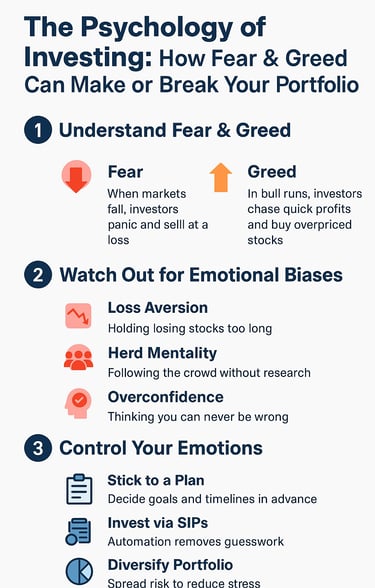🧠 The Psychology of Investing: How Fear & Greed Can Make or Break Your Portfolio
Introduction Investing is not just about numbers and charts — it’s about emotions. Two forces drive most investor decisions: fear and greed. If you learn to control them, you protect your wealth. If not, they can destroy it.
RAVINDRA PRAJAPATI
8/16/20251 min read
Step 1: Understand Fear & Greed
Fear: When markets fall, investors panic and sell at a loss.
Greed: In bull runs, investors chase quick profits and buy overpriced stocks.
👉 Both lead to poor long-term returns.
Step 2: Watch Out for Emotional Biases
Common traps that hurt investors:
Loss Aversion – Holding losing stocks too long.
Herd Mentality – Following the crowd without research.
Overconfidence – Thinking you can never be wrong.
Step 3: Control Your Emotions
Simple strategies to stay calm:
Stick to a Plan – Decide goals and timelines in advance.
Invest via SIPs – Automation removes guesswork.
Diversify Portfolio – Spread risk to reduce stress.
Avoid Overchecking Markets – Too much tracking triggers panic.
Conclusion
Your biggest enemy in investing is not the market — it’s your own emotions.
Control fear and greed, and you’ll stay on track for long-term wealth creation.
👉 Remember: Markets reward patience and discipline, not panic and greed.


RAVINDRA PRAJAPATI, Not a sebi registered
FOLLOW Us
ravindra.prajapati1122@gmail.com
+91 9795187745
© 2025. PiPiFinTech All rights reserved.
Contact Us
ABOUT Us
Our mission is to empower you to maximize every single penny and best solution for wealth generation and management for every mature age group.
Product TOPICS
Digital E-Wealth Platform
Mutual Funds
Education Planning
Insurance
FD and Bonds
Retirement Planning
Wealth Creation
(Disclaimers : Mutual Fund investments are subject to market risks, please read scheme related documents carefully.)
